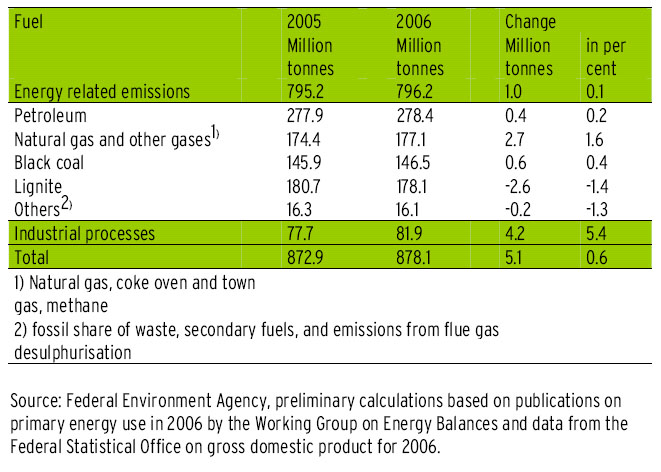Total emissions of the climate-relevant gas carbon dioxide (CO2) in Germany for the year 2006 rose by 0.6 per cent as compared to 2005. Overall CO2 emissions in 2006 amounted to 878 million tonnes, which is 5.1 million tonnes CO2 more than in the previous year. One cause for this increase lies in the 2.5 percent economic growth factor for 2006. Greater use of climate-friendly renewable energies such as wind power, hydrology, and biomass did manage to slow down the growth-related CO2 emissions by some 11 million tonnes CO2. On the other hand, there was a significant rise in emissions from industrial processes, with a 4.2-million-tonne spike in the past year representing 5.4 percent more than in 2005. So-called energy related CO2 emissions-- those created by the use of fossil fuels- increased negligibly, by about one million tonnes, that is, 0.1 percent more than in 2005. UBA President Prof. Dr. Andreas Troge said, “The economic upswing throughout Europe will continue to boost carbon dioxide emissions. We must therefore step climate protection up a notch.”
Energy related CO2 emissions stem from stationary and mobile combustion processes in the private sector and private households, whether it is from the power generating large firing installation, the heat generation for private households, or automotive engine combustion. Changes in the fuel mix in the generation of electricity increased overall CO2 emissions by 0.1 per cent.
The spike in economic growth was clearly felt in terms of emissions from industrial processes: all industrial sectors producing CO2 emissions (i.e. metal production and chemical industries) experienced moderate to great increases in production and, as a consequence, an increase in emissions.
It must be noted that compared to 2005 the use of renewable energies, especially biomass and wind energy, rose by 13.5 per cent in 2006. First calculations indicate that this rise avoided production of some 11 million tonnes CO2.
These initial UBA calculations are based on data from publications on primary energy use in 2006 by the Working Group on Energy Balances and data from the Federal Statistical Office on gross domestic product for 2006. UBA derived emissions figures by using a simplified calculation method. Results from emissions trading are not yet available for 2006 and have therefore not been entered into the calculations. More valid conclusions, including data on the various emitter groups, will likely only be possible after publication of detailed information on energy consumption towards the middle of this year.
Carbon dioxide emissions in Germany, real-time forecast for the year 2006, summary

